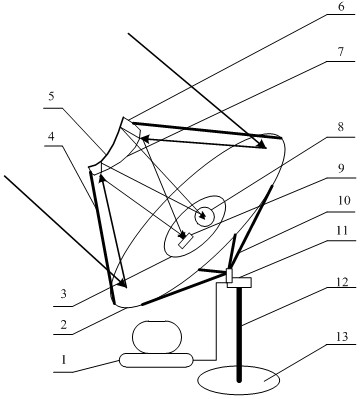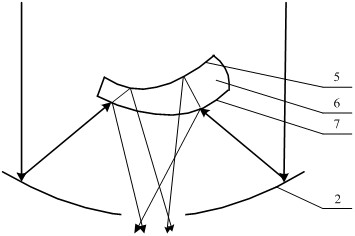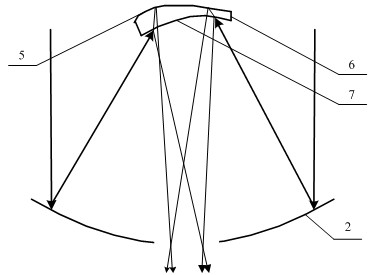Dish condensation-based solar energy secondary condensation frequency division method and device
A technology of secondary concentrating and frequency dividing device, applied in the field of solar power generation, can solve the problems of shortening service life, reducing photoelectric conversion efficiency, reducing the feasibility and flexibility of concentrating photovoltaic and combined solar thermal power generation, etc. energy consumption, improved balance and wind resistance
- Summary
- Abstract
- Description
- Claims
- Application Information
AI Technical Summary
Problems solved by technology
Method used
Image
Examples
Embodiment
[0027] The section diameter of the rotating parabolic dish reflector is 3500 mm, and the opening diameter of the light transmission hole is 600 mm. The mirror equation of the rotating parabolic dish reflector is The cross-sectional diameter of the crossover lens is 600 mm, and it is placed 1265 mm above the central axis of the rotating parabolic dish reflector. After the central axes coincide, the surface equation can be written as , the curved surface of the silver mirror rotates the coordinate system 4.6° in the opposite direction, so that the central axis coincides with the central axis of the rotating parabolic dish mirror, and its surface equation can be written as ; Concentrating photovoltaic panels and collector inlets were set at 700 mm and 350 mm below the rotating parabolic dish reflector, respectively.
[0028] In the spring sunny morning in East China, the spot diameter on the concentrated photovoltaic panel is about 200 mm, and the average energy flux density ...
PUM
 Login to View More
Login to View More Abstract
Description
Claims
Application Information
 Login to View More
Login to View More - R&D
- Intellectual Property
- Life Sciences
- Materials
- Tech Scout
- Unparalleled Data Quality
- Higher Quality Content
- 60% Fewer Hallucinations
Browse by: Latest US Patents, China's latest patents, Technical Efficacy Thesaurus, Application Domain, Technology Topic, Popular Technical Reports.
© 2025 PatSnap. All rights reserved.Legal|Privacy policy|Modern Slavery Act Transparency Statement|Sitemap|About US| Contact US: help@patsnap.com



